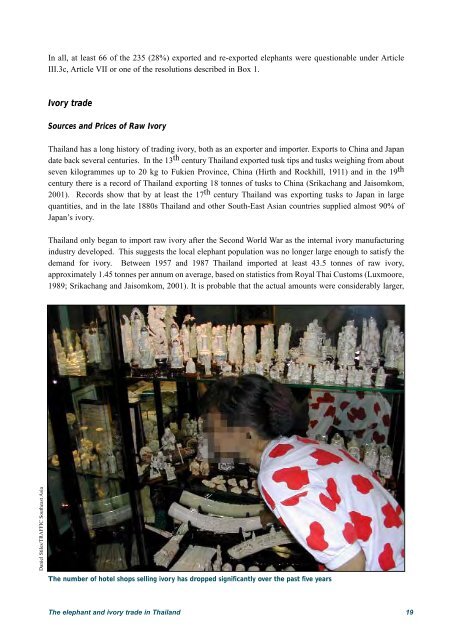The elephant and ivory trade in Thailand (PDF, 800 KB) - Traffic
The elephant and ivory trade in Thailand (PDF, 800 KB) - Traffic
The elephant and ivory trade in Thailand (PDF, 800 KB) - Traffic
Create successful ePaper yourself
Turn your PDF publications into a flip-book with our unique Google optimized e-Paper software.
In all, at least 66 of the 235 (28%) exported <strong>and</strong> re-exported <strong>elephant</strong>s were questionable under Article<br />
III.3c, Article VII or one of the resolutions described <strong>in</strong> Box 1.<br />
Ivory <strong>trade</strong><br />
Sources <strong>and</strong> Prices of Raw Ivory<br />
Thail<strong>and</strong> has a long history of trad<strong>in</strong>g <strong>ivory</strong>, both as an exporter <strong>and</strong> importer. Exports to Ch<strong>in</strong>a <strong>and</strong> Japan<br />
date back several centuries. In the 13 th century Thail<strong>and</strong> exported tusk tips <strong>and</strong> tusks weigh<strong>in</strong>g from about<br />
seven kilogrammes up to 20 kg to Fukien Prov<strong>in</strong>ce, Ch<strong>in</strong>a (Hirth <strong>and</strong> Rockhill, 1911) <strong>and</strong> <strong>in</strong> the 19 th<br />
century there is a record of Thail<strong>and</strong> export<strong>in</strong>g 18 tonnes of tusks to Ch<strong>in</strong>a (Srikachang <strong>and</strong> Jaisomkom,<br />
2001). Records show that by at least the 17 th century Thail<strong>and</strong> was export<strong>in</strong>g tusks to Japan <strong>in</strong> large<br />
quantities, <strong>and</strong> <strong>in</strong> the late 1880s Thail<strong>and</strong> <strong>and</strong> other South-East Asian countries supplied almost 90% of<br />
Japan’s <strong>ivory</strong>.<br />
Thail<strong>and</strong> only began to import raw <strong>ivory</strong> after the Second World War as the <strong>in</strong>ternal <strong>ivory</strong> manufactur<strong>in</strong>g<br />
<strong>in</strong>dustry developed. This suggests the local <strong>elephant</strong> population was no longer large enough to satisfy the<br />
dem<strong>and</strong> for <strong>ivory</strong>. Between 1957 <strong>and</strong> 1987 Thail<strong>and</strong> imported at least 43.5 tonnes of raw <strong>ivory</strong>,<br />
approximately 1.45 tonnes per annum on average, based on statistics from Royal Thai Customs (Luxmoore,<br />
1989; Srikachang <strong>and</strong> Jaisomkom, 2001). It is probable that the actual amounts were considerably larger,<br />
Daniel Stiles/TRAFFIC Southeast Asia<br />
<strong>The</strong> number of hotel shops sell<strong>in</strong>g <strong>ivory</strong> has dropped significantly over the past five years<br />
<strong>The</strong> <strong>elephant</strong> <strong>and</strong> <strong>ivory</strong> <strong>trade</strong> <strong>in</strong> Thail<strong>and</strong><br />
19

















